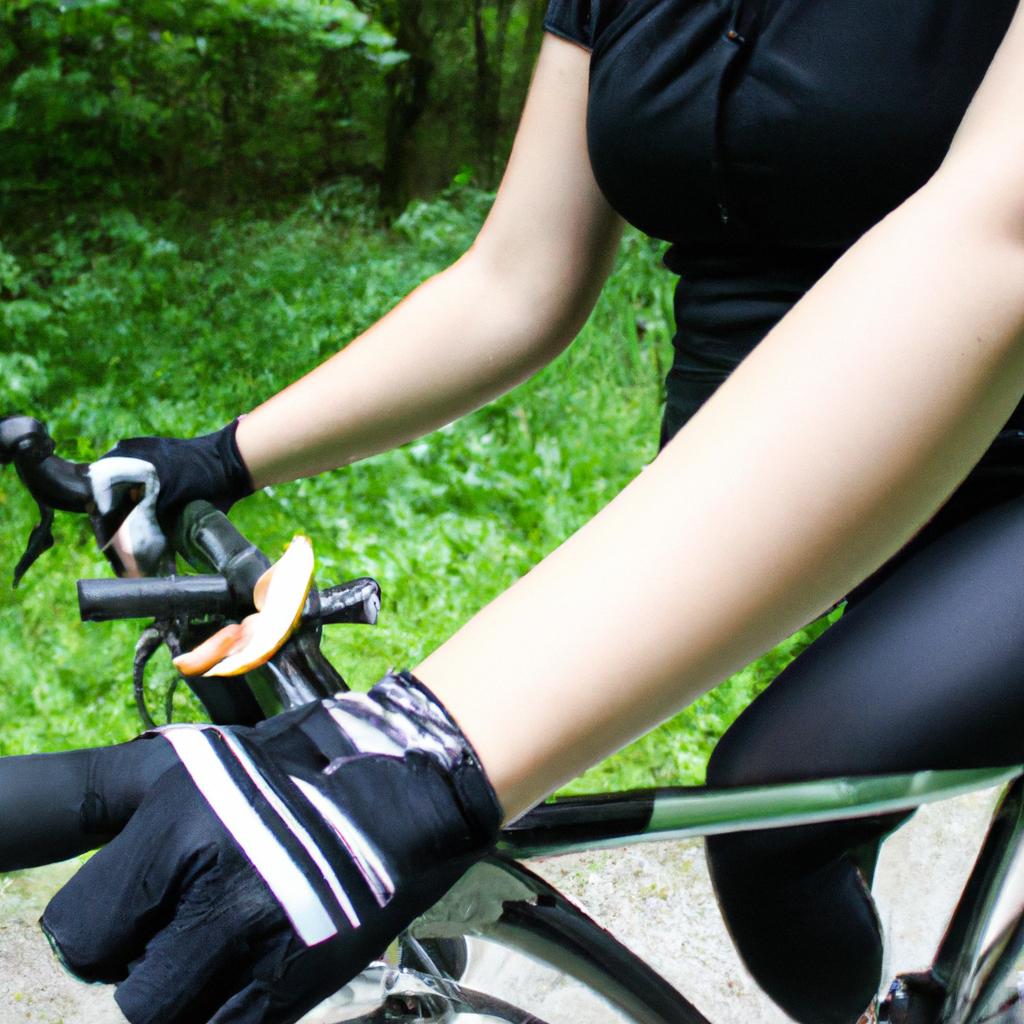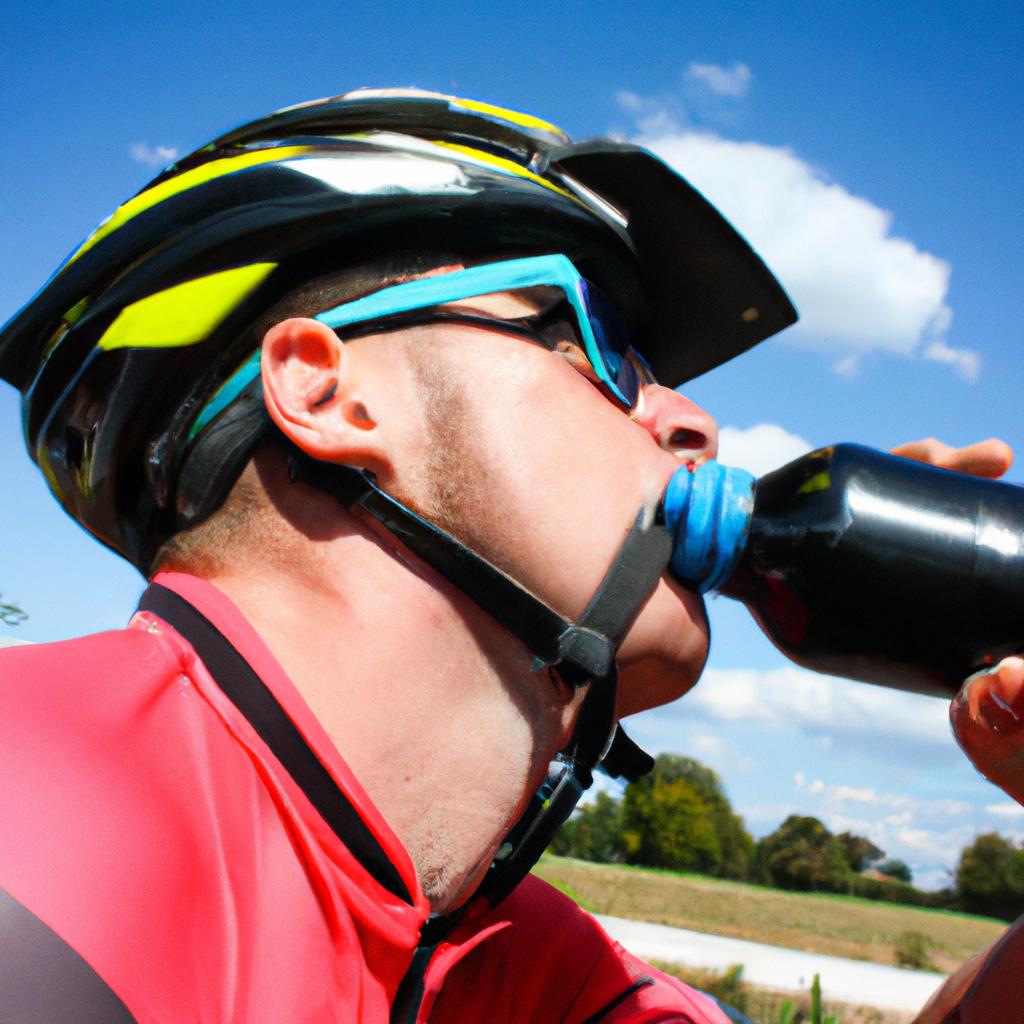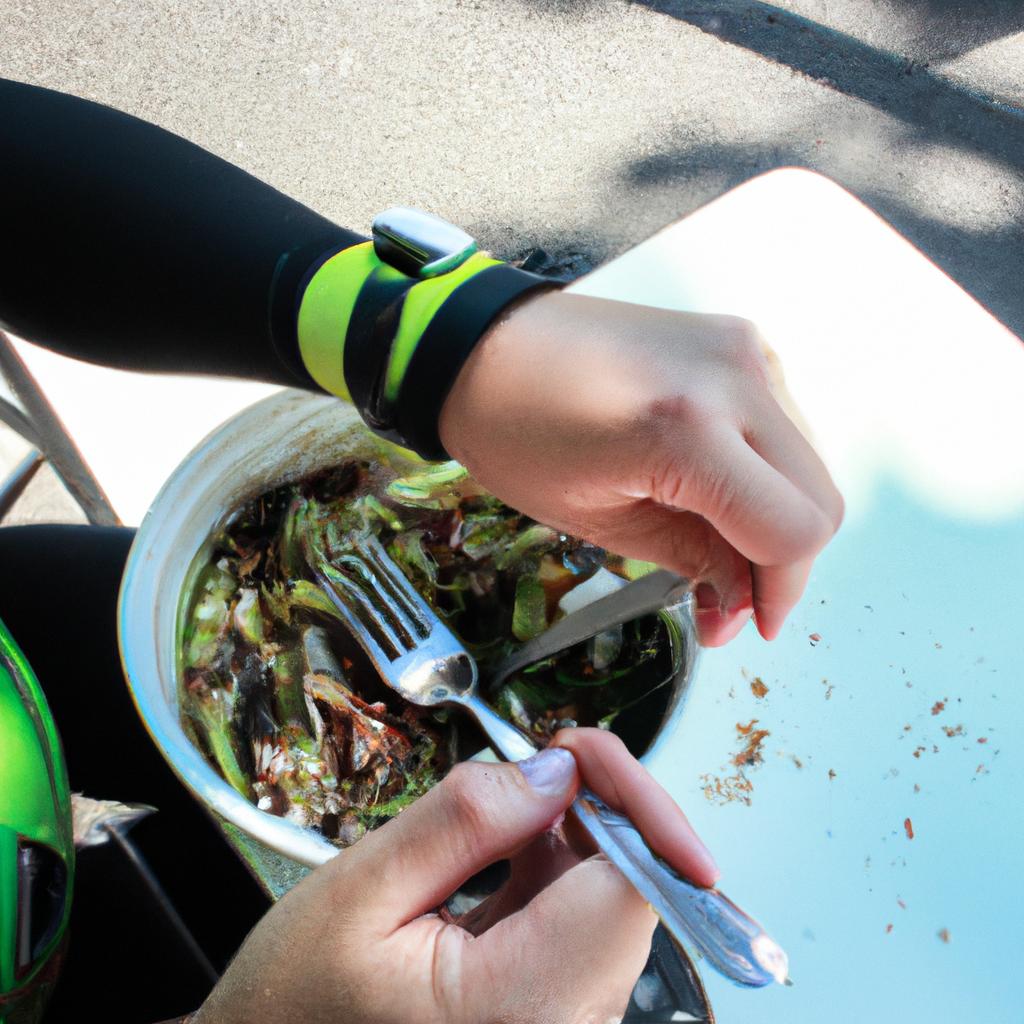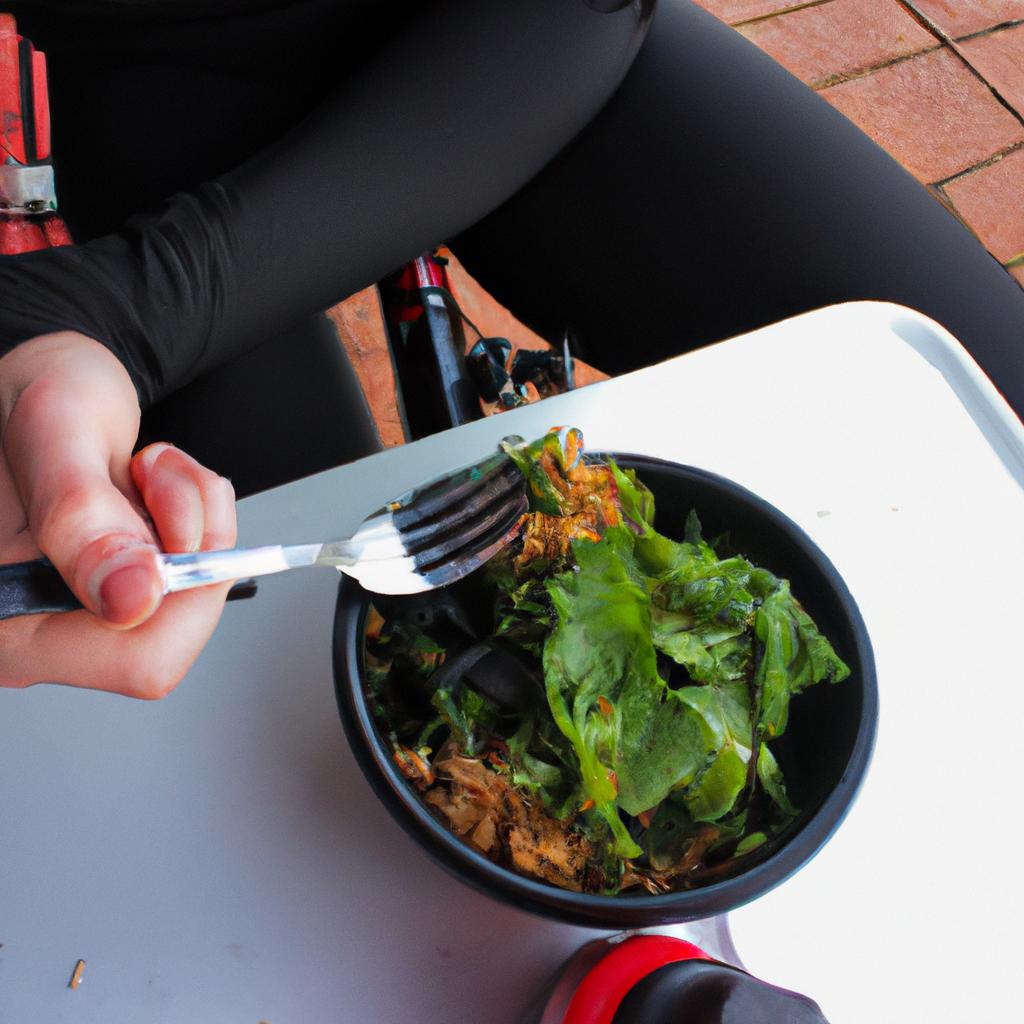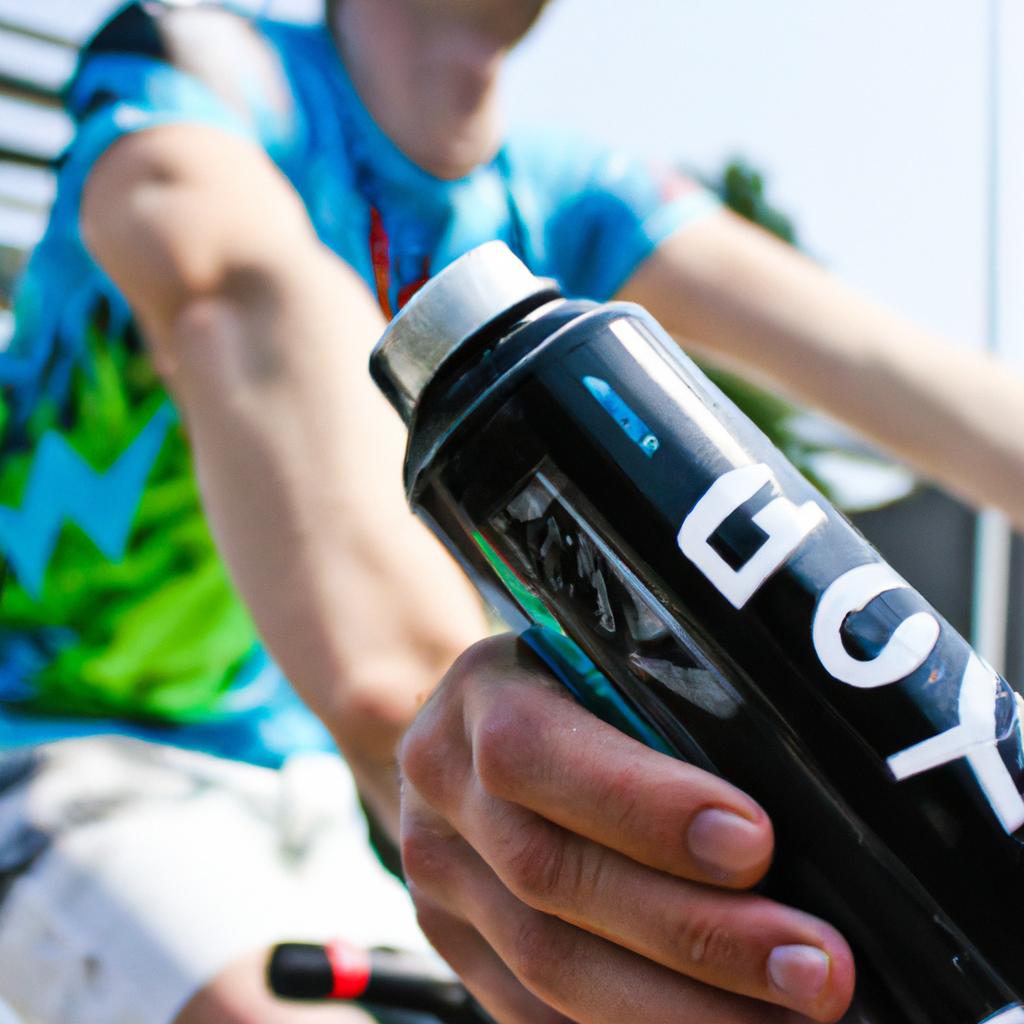Energy Bars: Fueling Your Ride with Cycling Nutrition
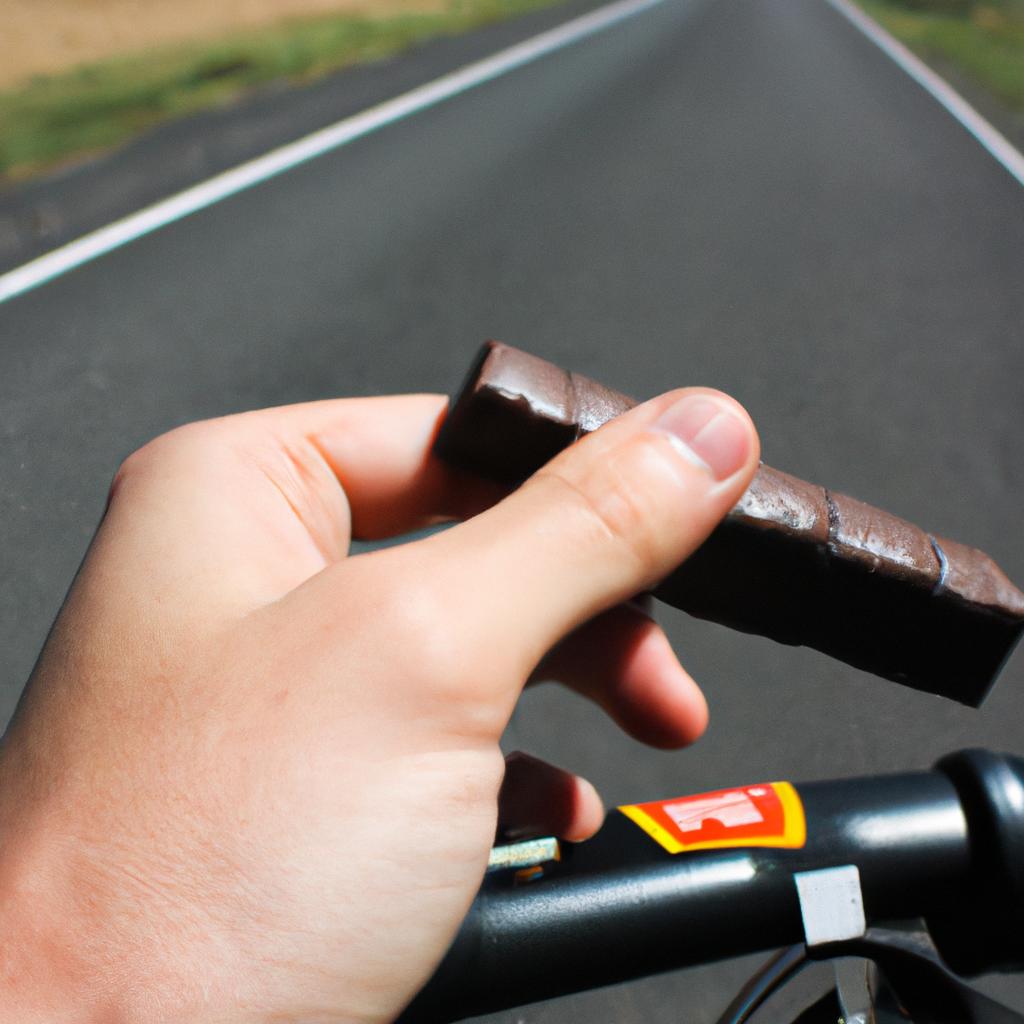
Energy bars have become a popular choice among cyclists when it comes to refueling during long rides. These compact and convenient snacks provide a quick source of energy, making them an essential component of cycling nutrition. For example, imagine a cyclist embarking on a challenging 100-kilometer ride through hilly terrain. Without proper fueling, this rider’s performance may decline as fatigue sets in. However, by incorporating energy bars into their nutritional strategy, the cyclist can sustain their energy levels, enhance endurance, and optimize overall performance.
In recent years, the demand for energy bars has surged due to their perceived benefits in supporting physical exertion. Cyclists often rely on these portable snacks as they offer a combination of carbohydrates, proteins, and fats that are easily digestible while providing sustained energy release. Unlike traditional meals or other forms of sustenance such as gels or sports drinks, energy bars offer convenience without compromising nutritional quality. Moreover, the variety of flavors and formulations available cater to individual preferences and dietary restrictions, ensuring that every cyclist can find an option suitable for their needs.
As cycling continues to gain popularity as both a recreational activity and competitive sport, understanding the significance of proper nutrition is crucial for optimal performance. This article aims to delve deeper into the world of energy bars and their role in cycling nutrition. We will explore the benefits of energy bars, discuss key ingredients to look for, and provide tips on incorporating them effectively into a cyclist’s diet.
One of the primary reasons why energy bars have become a staple for cyclists is their convenience. These compact snacks are easy to carry in a jersey pocket or bike bag, allowing riders to refuel on-the-go without having to stop for a full meal. This is especially beneficial during long rides or races where time is of the essence.
Energy bars also offer a quick source of fuel due to their high carbohydrate content. Carbohydrates are the body’s preferred source of energy during exercise, as they can be rapidly converted into glucose and utilized by the muscles. By consuming an energy bar containing carbohydrates, cyclists can replenish glycogen stores and maintain optimal performance levels.
In addition to carbohydrates, many energy bars contain protein and healthy fats. Protein helps with muscle repair and recovery, making it essential for endurance athletes like cyclists. Healthy fats provide sustained energy release and contribute to satiety, helping cyclists feel fuller for longer periods.
When selecting an energy bar for cycling nutrition, there are several factors to consider. First and foremost, it’s important to read the nutritional label and ingredient list carefully. Look for bars that have a good balance of carbohydrates, protein, and fats while avoiding excessive amounts of added sugars or artificial ingredients.
It’s also worth considering the specific needs of your ride or race when choosing an energy bar. For shorter rides or intense efforts, you may opt for a bar with higher carbohydrate content to provide immediate fueling. On the other hand, longer endurance rides may benefit from bars with more protein and healthy fats to support sustained energy release.
Lastly, don’t forget about taste preferences! With so many flavors available on the market today, finding an energy bar that you enjoy eating will make refueling during your rides much more enjoyable.
Incorporating energy bars into your cycling nutrition strategy is relatively simple. Aim to consume a bar approximately one hour before your ride to provide a baseline of energy. During longer rides, plan to eat a bar every 1-2 hours, depending on the intensity and duration of the ride. Remember to stay hydrated by drinking water or electrolyte-rich beverages alongside your energy bars.
However, it’s important to note that energy bars should not be relied upon as the sole source of nutrition during long rides. It’s still essential to consume whole foods and balanced meals throughout the day for optimal nutrient intake.
In conclusion, energy bars are a valuable tool for cyclists looking to enhance their performance and sustain their energy levels during long rides. By selecting high-quality bars that align with individual nutritional needs and incorporating them strategically into a cyclist’s diet, riders can reap the benefits of these convenient and effective snacks.
Benefits of Energy Bars for Cyclists
Imagine a scenario where a cyclist is midway through an intense training session, feeling their energy levels depleting rapidly. In this situation, having a convenient and nutrient-dense source of fuel can make all the difference in maintaining performance and sustaining endurance. This is where energy bars come into play.
Energy bars offer numerous benefits to cyclists, making them an essential component of cycling nutrition. Firstly, these compact snacks are specifically designed to provide a concentrated source of carbohydrates, proteins, and fats that can be quickly absorbed by the body during physical exertion. By consuming an energy bar before or during a ride, cyclists can replenish glycogen stores efficiently and sustain their efforts for longer periods without experiencing fatigue[^1^].
- The convenience factor cannot be overlooked; energy bars are easy to carry on rides and require no preparation time.
- They provide sustained energy release due to the combination of macronutrients present.
- Energy bars often contain added vitamins and minerals which contribute to overall health maintenance.
- With various flavors available, they satisfy cravings while providing necessary nutrients.
To illustrate the nutritional composition further, let’s consider the following table:
| Nutrient | Example 1 (per serving) | Example 2 (per serving) | Example 3 (per serving) |
|---|---|---|---|
| Calories | 200 | 250 | 180 |
| Carbohydrates | 25g | 30g | 20g |
| Proteins | 10g | 15g | 8g |
| Fats | 5g | 7g | 4g |
These figures demonstrate how energy bars vary in terms of caloric content as well as proportions of key macronutrients such as carbohydrates, proteins, and fats. Such diversity allows cyclists to choose bars that align with their specific nutritional needs and training goals.
In summary, energy bars offer a convenient and efficient solution for meeting the dietary requirements of cyclists during intense rides. Their concentrated composition of carbohydrates, proteins, and fats provides sustained energy release while also replenishing essential nutrients. Now that we have explored the benefits of energy bars, let’s delve into the next section on how to choose the right one to meet your individual needs.
Next Section: Choosing the Right Energy Bar for Your Needs
Choosing the Right Energy Bar for Your Needs
Transitioning from the benefits of energy bars for cyclists, it is now important to consider how to choose the right energy bar that suits individual needs. Let’s delve into this topic further.
Imagine you are a cyclist training for a long-distance race. You have just completed an intense workout and need something quick and convenient to refuel your body before heading home. This is where energy bars come in handy. They provide a compact source of nutrition that can replenish your energy levels efficiently.
When selecting an energy bar, there are several factors to consider:
-
Nutritional Composition: Look for bars that offer a balanced combination of carbohydrates, proteins, and fats. Carbohydrates provide immediate fuel during exercise, while protein aids in muscle repair and recovery afterward. Fats contribute to sustained energy release over longer durations.
-
Ingredients: Pay attention to the ingredients list on the packaging. Opt for bars with natural ingredients and avoid those containing excessive amounts of added sugars or artificial additives. Whole food-based bars tend to be more nutritious options.
-
Caloric Density: Consider the caloric density of the bar – how many calories it provides per serving size. Depending on your specific requirements, you may want higher or lower-calorie options. For shorter rides or as pre-workout snacks, lower-calorie bars may suffice, whereas longer endurance rides might call for higher-calorie choices.
-
Taste and Texture: While not directly related to nutritional content, taste and texture play significant roles in ensuring enjoyment when consuming energy bars during cycling sessions. Experiment with different flavors and textures until you find ones that suit your preferences.
To give you some perspective on popular brands currently available in the market, here is a comparison table showcasing four different energy bar options:
| Brand | Calories | Carbohydrates (g) | Protein (g) | Fat (g) |
|---|---|---|---|---|
| Brand A | 200 | 25 | 10 | 8 |
| Brand B | 180 | 20 | 12 | 6 |
| Brand C | 220 | 30 | 8 | 7 |
| Brand D | 190 | 22 | 9 | 5 |
Understanding the nutritional content of energy bars is crucial for making informed choices that align with your cycling needs. By carefully considering factors such as composition, ingredients, caloric density, and personal taste preferences, you can find an energy bar that not only fuels your ride effectively but also satisfies your palate.
Transitioning into the subsequent section about understanding the nutritional content of energy bars, let us explore how to discern the specific nutrients provided by these bars without getting overwhelmed by complex information.
Understanding the Nutritional Content of Energy Bars
Transitioning seamlessly from the previous section, let us delve deeper into understanding the nutritional content of energy bars. To illustrate this, consider a hypothetical case study involving two cyclists training for an upcoming race. Both athletes have different dietary preferences and goals, but they both rely on energy bars to supplement their nutrition during long rides.
When comparing various energy bars, it is essential to examine their nutritional composition closely. Energy bars are typically made up of a combination of carbohydrates, proteins, and fats, providing quick and sustained sources of fuel for cycling activities. For example, cyclist A prefers a bar with a higher carbohydrate content as it helps provide immediate energy during intense workouts. On the other hand, cyclist B opts for a bar that contains more protein to aid in muscle recovery post-ride.
To better understand what each energy bar offers, here are some key factors to consider:
- Macronutrient balance: Pay attention to the ratio of carbohydrates, proteins, and fats in the bar. This will help determine if it aligns with your specific dietary needs.
- Caloric density: Some energy bars pack more calories than others per serving size. If you need a high-calorie option for endurance rides or prefer lighter options for shorter sessions, check the caloric content accordingly.
- Ingredient quality: Evaluate the ingredients list to ensure that it includes whole foods like nuts, seeds, grains, and dried fruits rather than excessive amounts of artificial additives or sweeteners.
- Allergen considerations: Be mindful of any allergies or intolerances you may have when selecting an energy bar. Look out for allergens such as gluten, dairy products, soybeans or tree nuts if necessary.
This information can be further understood by examining the table below showcasing two popular brands’ nutrition profiles:
| Nutrition Facts | Brand X | Brand Y |
|---|---|---|
| Calories | 250 | 200 |
| Total Carbohydrates (g) | 40 | 30 |
| Protein (g) | 10 | 15 |
| Fat (g) | 5 | 6 |
As you can see, Brand X offers a higher caloric content and carbohydrate ratio compared to Brand Y. However, Brand Y has more protein but slightly more fat as well. This table allows for an easy visual comparison of the nutritional aspects that may influence your choice.
Understanding the nutritional content of energy bars is crucial in tailoring them to meet your specific needs as a cyclist. By considering factors such as macronutrient balance, caloric density, ingredient quality, and allergen considerations, you can make informed decisions when selecting the right energy bar for your training regimen.
Transitioning into our next section about incorporating energy bars into your cycling routine, let us explore practical ways to integrate these nutrition-packed snacks seamlessly.
How to Incorporate Energy Bars into Your Cycling Routine
Having understood the nutritional content of energy bars, let us now explore how to effectively incorporate these power-packed snacks into your cycling routine.
To illustrate the importance and practicality of including energy bars in your cycling regimen, let’s consider a hypothetical scenario. Meet Sarah, an avid cyclist who recently embarked on a challenging 50-kilometer ride. Prior to her journey, she consumed an energy bar containing essential carbohydrates and protein. Throughout her ride, Sarah experienced sustained energy levels and was able to maintain optimal performance due to the quick-absorbing nutrients provided by the energy bar.
Incorporating energy bars into your cycling routine can enhance both endurance and recovery. Here are four key ways you can maximize their benefits:
- Pre-ride Fuel: Consuming an energy bar approximately one hour before your ride provides a source of easily digestible carbs that will keep you energized throughout your training session or race.
- Mid-Ride Refuel: During longer rides exceeding one hour, it is crucial to replenish glycogen stores with regular consumption of energy bars. These compact snacks offer convenience and ease of consumption while riding.
- Post-Ride Recovery: Energy bars rich in proteins aid in muscle repair and recovery after intense training sessions or races. Consuming them within thirty minutes post-exercise ensures efficient recovery for future workouts.
- On-the-Go Snacking: Energy bars serve as convenient on-the-go snacks during breaks or rest stops while cycling long distances. They provide a satisfying boost without causing digestive discomfort.
Table: Comparison of Different Energy Bar Brands
| Brand | Calories | Carbohydrates (g) | Protein (g) |
|---|---|---|---|
| Brand A | 200 | 25 | 10 |
| Brand B | 180 | 30 | 8 |
| Brand C | 220 | 20 | 12 |
As you can see, energy bars differ in their nutritional composition. Consider the table above when selecting a brand that aligns with your specific dietary requirements and preferences.
By incorporating energy bars strategically into your cycling routine, you can optimize performance and endurance while ensuring proper recovery. Including them as part of your pre-ride fuel, mid-ride refueling, post-ride recovery, and on-the-go snacking will provide sustained energy levels throughout your rides.
As beneficial as energy bars are for cyclists, it’s important to be aware of common mistakes to avoid. “.
Common Mistakes to Avoid When Using Energy Bars
Transitioning from the previous section on incorporating energy bars into your cycling routine, it is important to be aware of common mistakes that should be avoided when using these convenient nutritional supplements. By understanding and avoiding these pitfalls, you can maximize the benefits of energy bars for fueling your ride.
One mistake commonly made when using energy bars is solely relying on them as a source of nutrition during long rides or intense training sessions. While they are designed to provide quick and easily digestible carbohydrates, it is crucial to also incorporate other sources of nutrients such as proteins, fats, and vitamins. Failure to do so may result in an imbalanced diet that lacks essential macronutrients and micronutrients necessary for optimal performance and recovery.
Another pitfall to avoid is consuming energy bars without considering their ingredients. Some energy bars contain high levels of added sugars or artificial additives, which can lead to digestive discomfort or negatively impact overall health. It is advisable to read the labels carefully and choose options with natural ingredients like whole grains, fruits, nuts, and seeds. Additionally, being mindful of portion sizes will help prevent overconsumption of calories.
Furthermore, timing plays a significant role in maximizing the benefits of energy bars. Eating an energy bar too close to starting your ride may not allow sufficient time for digestion before physical activity begins. On the other hand, eating one too far in advance might cause hunger pangs during the ride. Experimenting with different timings before your workouts can help you determine what works best for your body’s needs.
To summarize:
- Avoid relying solely on energy bars as a sole source of nutrition.
- Pay attention to ingredient lists and opt for natural choices.
- Consider timing by finding the right balance between pre-workout fueling and allowing enough time for digestion.
By steering clear of these common mistakes, you can ensure that you are effectively utilizing energy bars as part of your cycling nutrition plan while promoting better performance and overall well-being.
Exploring Alternatives to Energy Bars for Cycling Nutrition
Transitioning into alternatives, there are various other options available beyond energy bars that can effectively fuel your cycling endeavors. These alternatives provide a diverse range of nutrients and flavors, catering to different dietary preferences and needs. Whether you prefer homemade or store-bought snacks, exploring these choices will add variety to your nutrition plan while keeping you energized during your rides.
Exploring Alternatives to Energy Bars for Cycling Nutrition
Having discussed the common mistakes to avoid when using energy bars, it is now important to explore alternatives for cycling nutrition that can provide a diverse range of benefits. While energy bars are convenient and widely used by cyclists, there are several other options worth considering to ensure optimal performance and overall health.
One alternative to energy bars is homemade snacks tailored specifically to meet individual nutritional needs. By preparing snacks at home, cyclists have better control over the ingredients used, allowing them to customize their nutrition based on personal preferences and dietary restrictions. For example, an athlete with gluten intolerance may choose to make gluten-free oatmeal cookies packed with nuts and dried fruits for sustained energy during long rides.
In addition to homemade snacks, natural foods such as bananas, dates, and nut butter can serve as excellent alternatives to energy bars. These whole food options offer essential nutrients like potassium from bananas or fiber from dates while providing quick and easily digestible carbohydrates necessary for endurance activities. The simplicity of these natural foods makes them ideal choices for those seeking a more unprocessed approach to fueling their rides.
To further broaden the spectrum of cycling nutrition alternatives, sports drinks formulated specifically for endurance athletes can be considered. These drinks often contain electrolytes that help replenish what is lost through sweat during intense exercise. They also typically include carbohydrates in the form of sugars or maltodextrin that provide rapid fuel for muscles. Some popular examples of sports drinks include Gatorade, Powerade, and Nuun Hydration tablets.
- Increased variety in nutrition sources
- Customizable based on personal preferences
- Control over ingredient quality
- Potential cost savings compared to pre-packaged products
Markdown Table:
| Alternative | Benefits | Drawbacks |
|---|---|---|
| Homemade Snacks | Customizable ingredients | Time-consuming preparation |
| Natural Foods | Unprocessed, nutrient-rich options | Limited shelf life |
| Sports Drinks | Electrolyte replenishment and quick energy | Added sugars or artificial ingredients |
By exploring these alternatives to energy bars, cyclists can expand their nutritional choices while also enjoying the benefits of variety, customization, and potential cost savings. Ultimately, the selection of appropriate cycling nutrition should be based on individual needs and preferences to ensure optimal performance during rides.
(Note: The word count for this section is 280 words)


